Flexural Strengthening of Stone Masonry Walls Using Textile-Reinforced Sarooj Mortar
Abstract
1. Introduction
2. Material Properties
2.1. Limestone
2.2. Sarooj
2.3. Bed Joints Mortar
2.4. Plaster Mortar
2.5. Basalt Textile
3. Stone Masonry Wall Construction and Test Setup
3.1. Compressive Strength of Masonry
3.2. Wall Specimens
3.2.1. CASE I: Unreinforced Masonry Wall (UC)
3.2.2. CASE II: Wall Reinforced by Basalt Textile (RT)
3.2.3. CASE III: Wall Reinforced by Basalt Textile and Stainless-Steel Screws and Washers (RTS)
3.2.4. CASE IV: Wall Reinforced by Basalt Mesh and Basalt Ropes (RTR)
4. Test Set up for Wall Bending Tests
5. Bending Test Results of Stone Masonry Walls
6. Estimating the Moment Capacity of the Strengthened Walls
7. Conclusions
- Sarooj mortar is compatible with stone masonry structures based on the investigated physical and chemical properties of the stones and sarooj. The compatibility of the strengthening system is vital in preserving historical structures.
- The unreinforced masonry specimen (UC) showed sudden brittle failure due to the opening of a single horizontal crack.
- All reinforced specimens exhibited a relatively ductile behavior before failure compared to the URM wall, with increases in the maximum deflection before failure of 130%, 106%, and 21% for RT, RTS, and RTR walls, respectively.
- All strengthened specimens failed due to textile rupture when the basalt textile reached its ultimate strain.
- The strengthened specimens resisted an out-of-plane bending moments of about 2.5 to 3 times that of the unreinforced specimen (a 160–233% increase). The strengthening method using textile mesh in addition to screws and washers (RTS) was the most efficient method.
Author Contributions
Funding
Institutional Review Board Statement
Informed Consent Statement
Data Availability Statement
Conflicts of Interest
References
- Maccarini, H.; Vasconcelos, G.; Rodrigues, H.; Ortega, J.; Lourenço, P.B. Out-of-plane behavior of stone masonry walls: Experimental and numerical analysis. Constr. Build. Mater. 2018, 179, 430–452. [Google Scholar] [CrossRef]
- Hegazy, S.M. Conservation of historical buildings–The Omani-French museum as a case study. HBRC J. 2015, 11, 264–274. [Google Scholar] [CrossRef][Green Version]
- Bernat-Maso, E.; Escrig, C.; Aranha, C.; Gil, L. Experimental assessment of textile reinforced sprayed mortar. Constr. Build. Mater. 2014, 50, 226–236. [Google Scholar] [CrossRef]
- Al-Rawas, A.; Hago, A. Evaluation of field and laboratory produced burnt clay pozzolans. Appl. Clay Sci. 2006, 31, 29–35. [Google Scholar] [CrossRef]
- Ehsani, M.R.; Saadatmanesh, H.; Al-Saidy, A. Shear behavior of URM retrofitted with FRP overlays. J. Compos. Constr. 1997, 2, 17–25. [Google Scholar] [CrossRef]
- Triantafillou, T. Strengthening of masonry structures using epoxy-bonded FRP laminates. J. Compos. Constr. 1998, 2, 96–104. [Google Scholar] [CrossRef]
- Kouris, L.A.S.; Triantafillou, T.C. State-of-the-art on strengthening of masonry structures with textile reinforced mortar (TRM). Constr. Build. Mater. 2018, 188, 1221–1233. [Google Scholar] [CrossRef]
- Triantafillou, T.C.; Papanicolaou, C.G.; Zissimopoulos, P.; Laourdekis, T. Concrete confinement with textile-reinforced mortar jackets. ACI Mater. J. 2006, 103, 28. [Google Scholar]
- Babatunde, S.A. Review of strengthening techniques for masonry using fiber reinforced polymers. Compos. Struct. 2017, 161, 246–255. [Google Scholar] [CrossRef]
- Kolsch, H. Carbon fiber cement matrix (CFCM) overlay system for masonry strengthening. J. Compos. Constr. 1998, 2, 105–109. [Google Scholar] [CrossRef]
- Papanicolaou, C.; Triantafillou, T.; Lekka, M. Externally bonded grids as strengthening and seismic retrofitting materials for masonry panels. Constr. Build. Mater. 2011, 25, 504–514. [Google Scholar] [CrossRef]
- Pinho, F.; Luco, V.; Baiao, M. Rubble stone masonry walls strengthened by three-dimensional steel ties and textile reinforced mortar render under compression. Int. J. Archit. Herit. 2014, 8, 670–689. [Google Scholar] [CrossRef]
- Harajli, M.; ElKhatib, H.; San-Jose, J.T. Static and cyclic out-of-plane response of masonry walls strengthened using textile-mortar system. J. Mater. Civ. Eng. 2010, 22, 1171–1180. [Google Scholar] [CrossRef]
- Papanicolaou, C.G.; Triantafillou, T.C.; Papathanasiou, M.; Karlos, K. Textile reinforced mortar (TRM) versus FRP as strengthening material of URM walls: Out-of-plane cyclic loading. Mater. Struct. 2008, 41, 143–157. [Google Scholar]
- Padalu, P.K.V.R.; Singh, Y.; Das, S. Efficacy of basalt fibre reinforced cement mortar composite for out-of-plane strengthening of unreinforced masonry. Constr. Build. Mater. 2018, 191, 1172–1190. [Google Scholar] [CrossRef]
- Jacopo, D.; Gianluca, M.; Stefano, L.; Valeria, C.; Enrico, Q. TRM reinforced tuff and fired clay brick masonry: Experimental and analytical investigation on their in-plane and out-of-plane behavior. Constr. Build. Mater. 2021, 272, 121643. [Google Scholar]
- Gkournelos, D.G.; Azdejković, L.D.; Triantafillou, T.C. Innovative and Eco-friendly Solutions for the Seismic Retrofitting of Natural Stone Masonry Walls with Textile Reinforced Mortar: In- and Out-of-Plane Behavior. J. Compos. Constr. 2022, 26, 04021061. [Google Scholar] [CrossRef]
- Thomoglou, A.K.; Karabini, M.A.; Achillopoulou, D.V.; Rousakis, T.C.; Chalioris, C.E. Failure Mode Prediction of Unreinforced Masonry (URM) Walls Retrofitted with Cementitious Textile Reinforced Mortar (TRM). Fibers 2023, 11, 53. [Google Scholar] [CrossRef]
- Hago, A.; Al-Rawas, A. Properties of the Omani sarooj. Eng. J. Univ. Qatar 1997, 10, 81–91. [Google Scholar]
- Hago, A.; Al-Rawas, A.; Al-Sidairi, A. Effect of the fineness of artificial pozzolana (Sarooj) on the properties of lime-pozzolana mixes. Sci. Technol. 2002, 7, 251–258. [Google Scholar] [CrossRef]
- Hago, A.; Al-Rawas, A.; Al-Riyami, A. Effect of varying cement content and curing conditions on the properties of sarooj. Build. Environ. 2002, 37, 45–53. [Google Scholar] [CrossRef]
- ASTM C51; Standard Terminology Relating to Lime and Limestone. American Society for Testing and Materials: West Conshohocken, PA, USA, 2011.
- ASTM C 25-11; Standard Test Methods for Chemical Analysis of Limestone, Quicklime, and Hydrated Lime. American Society for Testing and Materials: West Conshohocken, PA, USA, 2014.
- ASTM D7012; Standard Test Methods for Compressive Strength and Elastic Moduli of Intact Rock Core Specimens under Varying States of Stress and Temperatures. American Society for Testing and Materials: West Conshohocken, PA, USA, 2004.
- ASTM D6473; Standard Test Method for Specific Gravity and Absorption of Rock for Erosion Control. American Society for Testing and Materials: West Conshohocken, PA, USA, 2010.
- ASTM C 114-13; Standard Test Methods for Chemical Analysis of Hydraulic Cement. American Society for Testing and Materials: West Conshohocken, PA, USA, 2015.
- ASTM C618; Specifications for Fly Ash and Raw or Calcined Natural Pozzolana for Use as a Mineral Admixture in Portland cement. American Society for Testing and Materials: West Conshohocken, PA, USA, 1980.
- ASTM D5034-09; Standard Test Method for Breaking Strength and Elongation of Textile Fabrics (Grab Test). American Society for Testing and Materials: West Conshohocken, PA, USA, 2017.
- Dong, Z.; Deng, M.; Zhang, Y.; Ma, P. Strengthening of unreinforced masonry walls against out-of-plane loads using carbon textile reinforced mortar optimized by short PVA fibers. Eng. Struct. 2021, 227, 111433. [Google Scholar] [CrossRef]
- Ibrahim, M.; Galal, M.; Kohail, M.; Rashad, A.; ElShafie, H. Behaviour of unreinforced masonry walls retrofitted by using basalt textile reinforced mortar. Eng. Struct. 2022, 260, 114201. [Google Scholar] [CrossRef]
- Deng, M.; Dong, Z.; Dai, J.; Zhao, X. Out-of-plane strengthening of URM walls using different fiber-reinforced materials. Constr. Build. Mater. 2023, 362, 129597. [Google Scholar] [CrossRef]





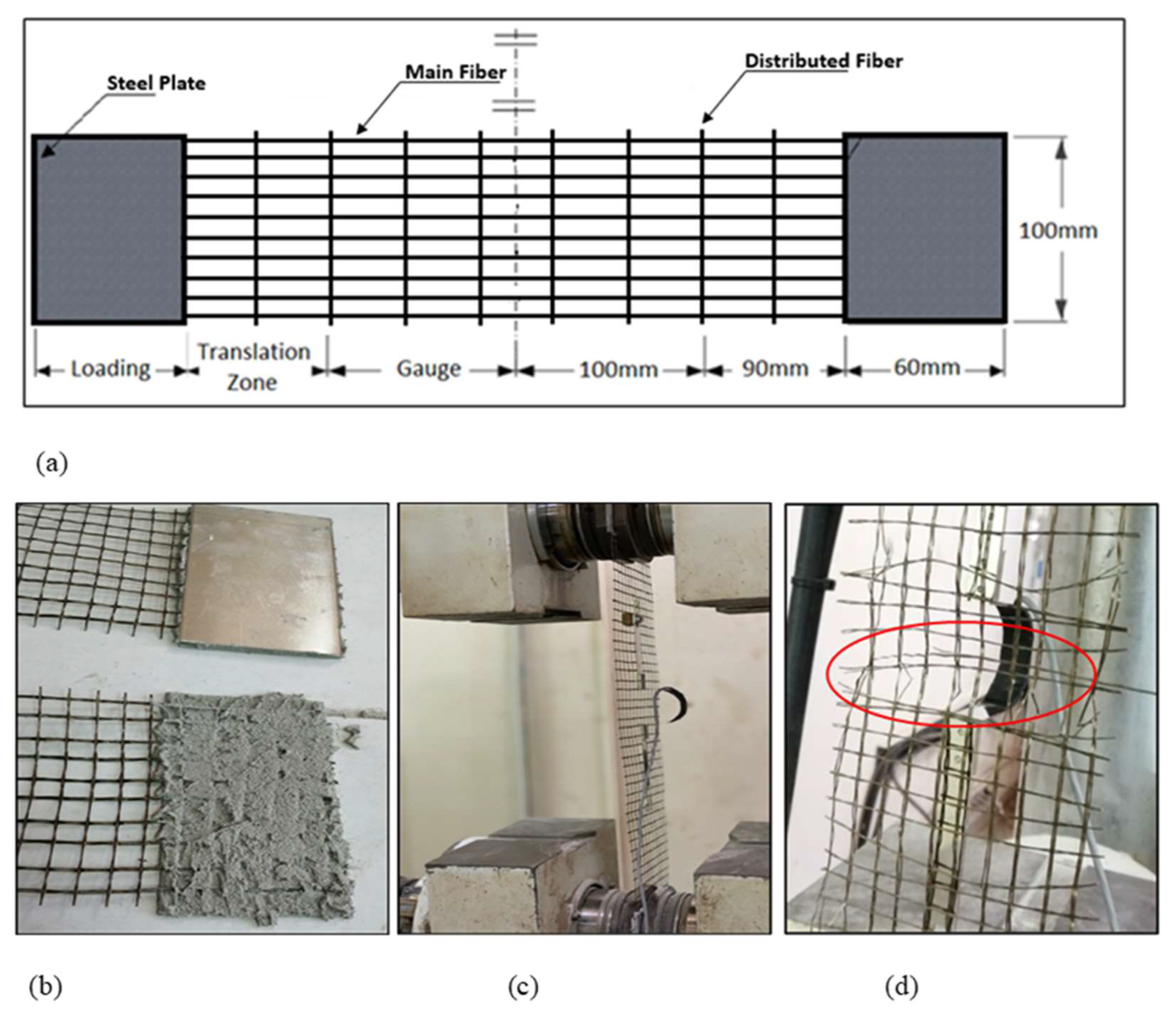
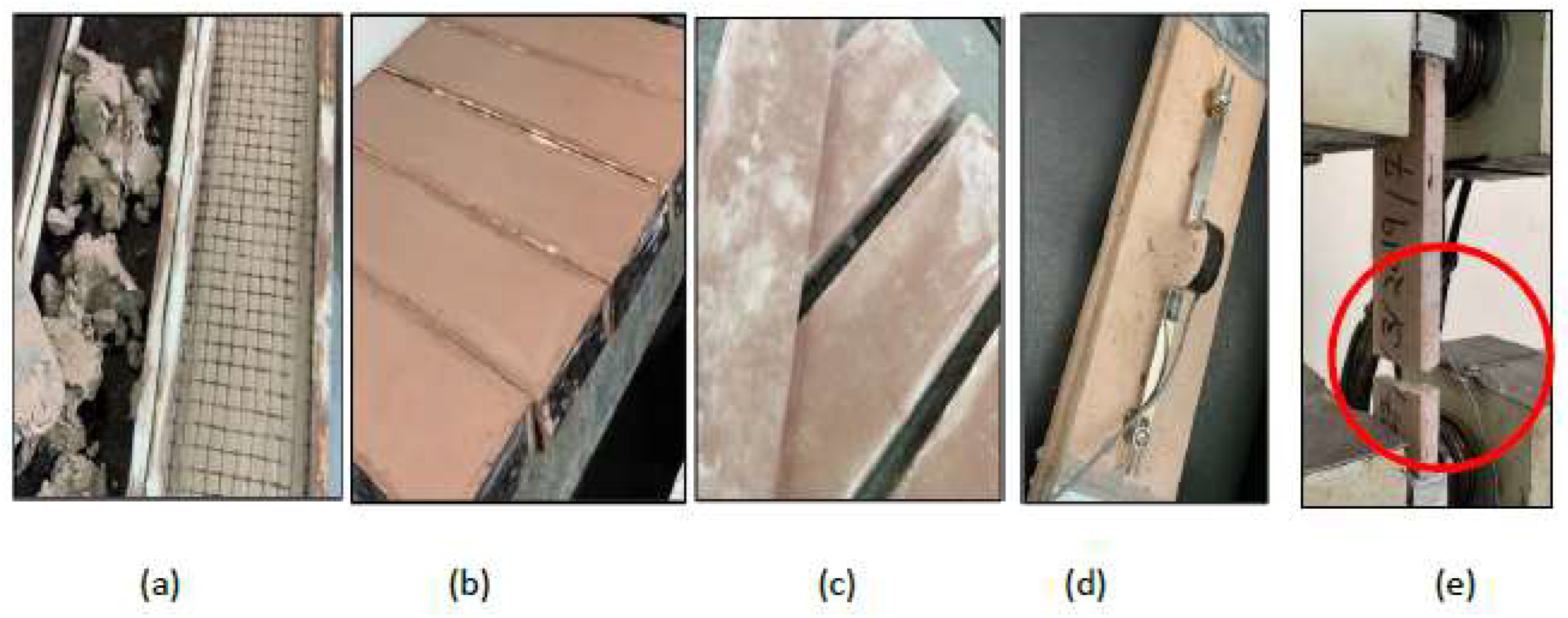

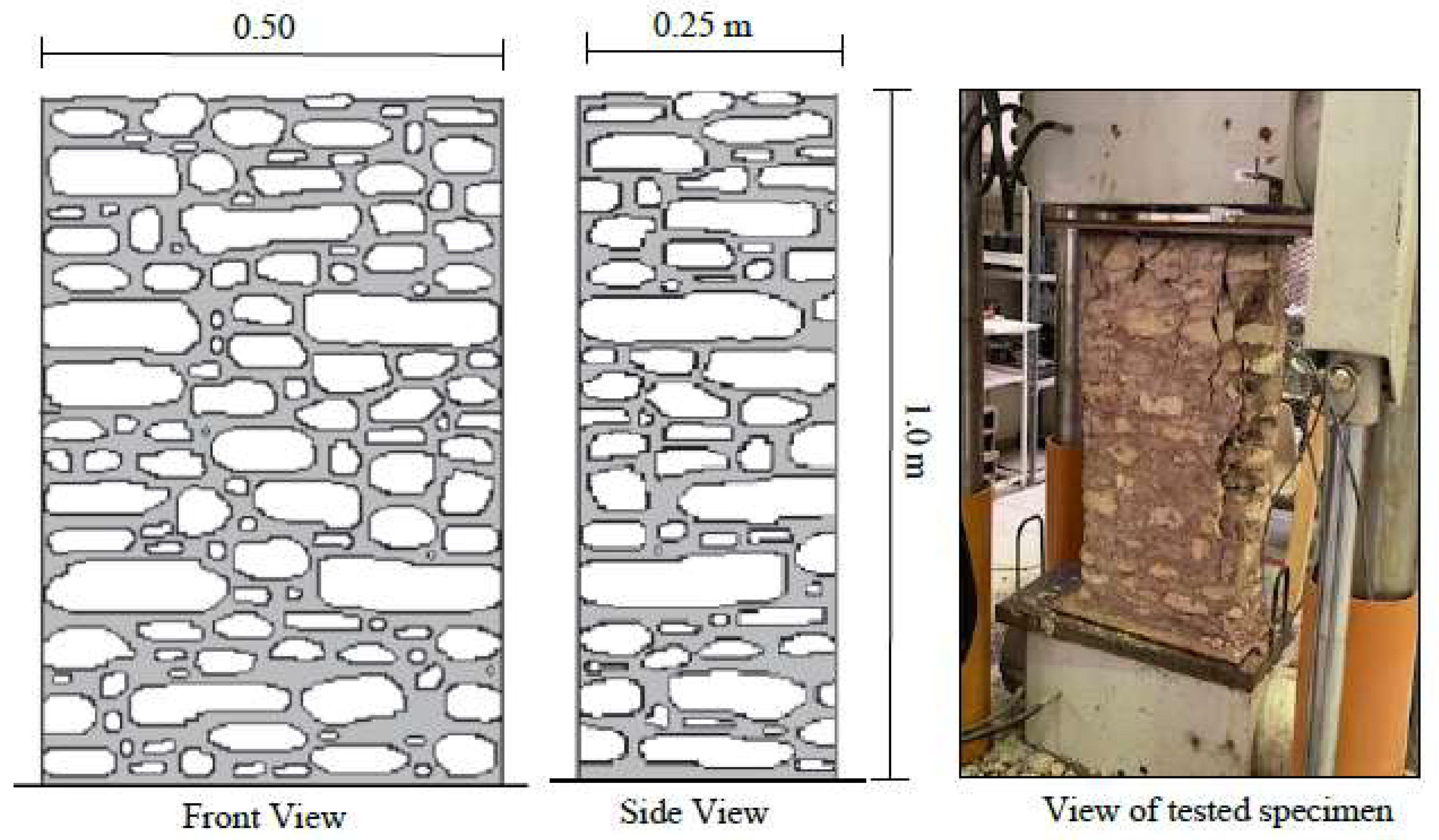
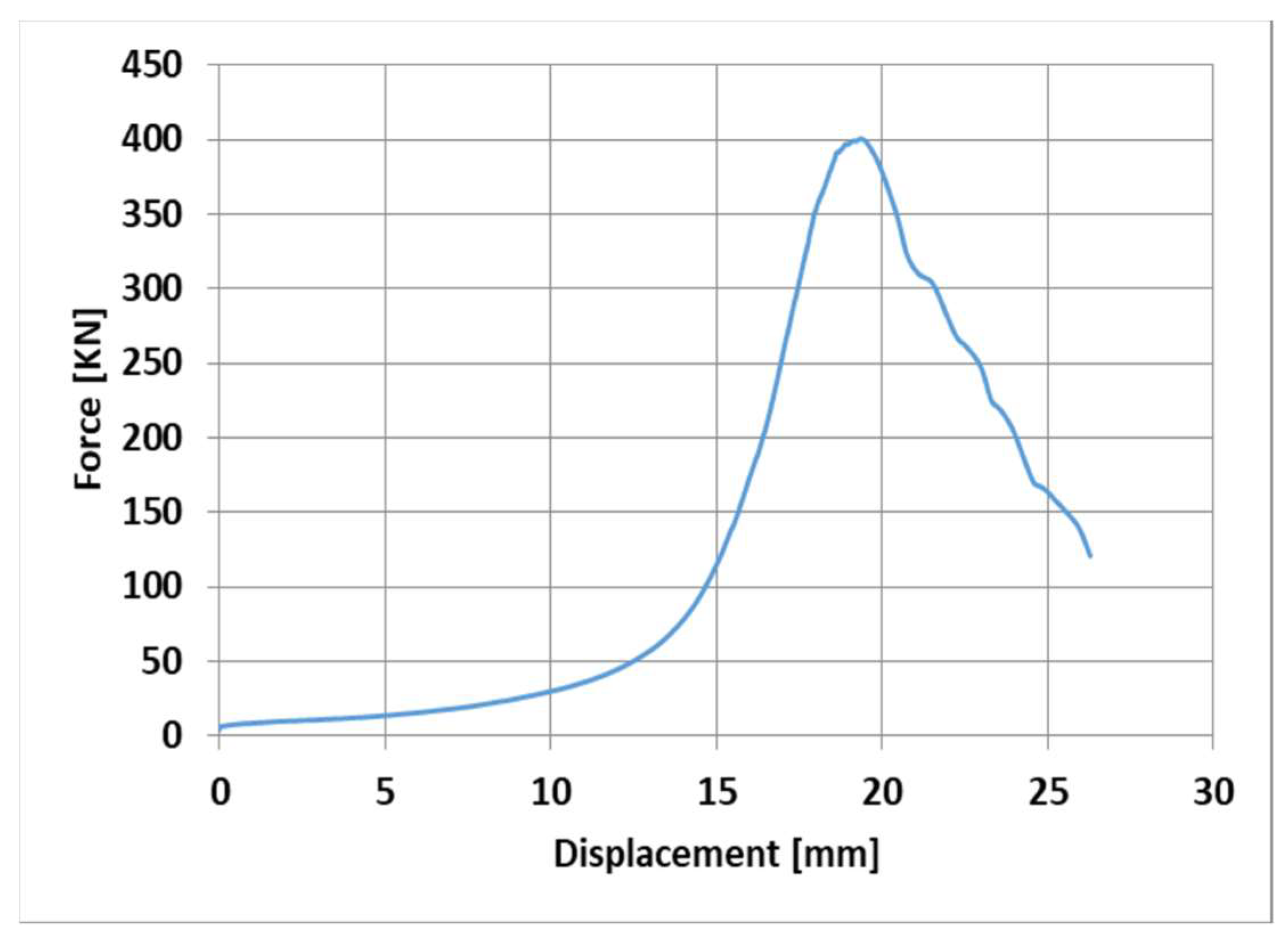
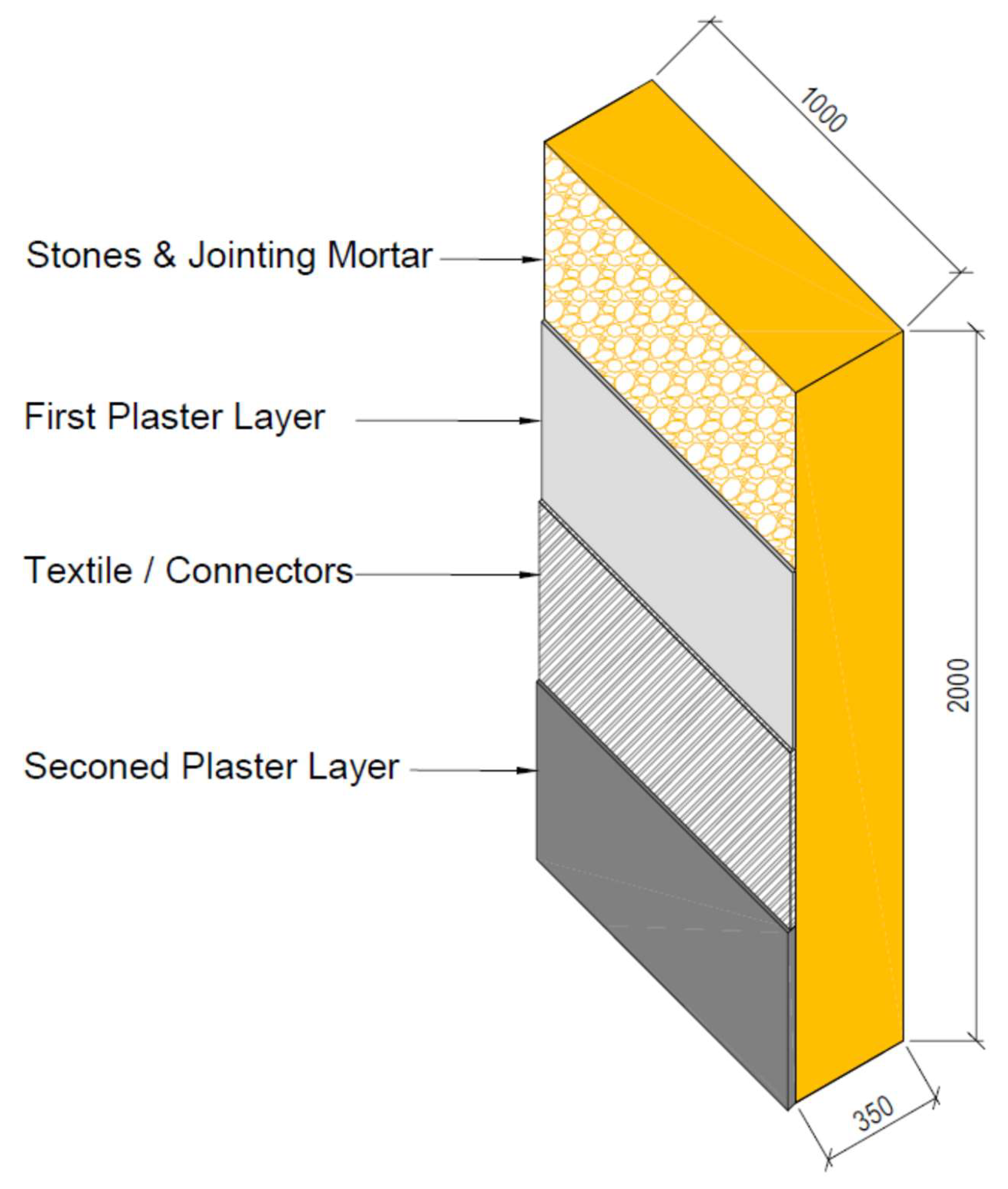
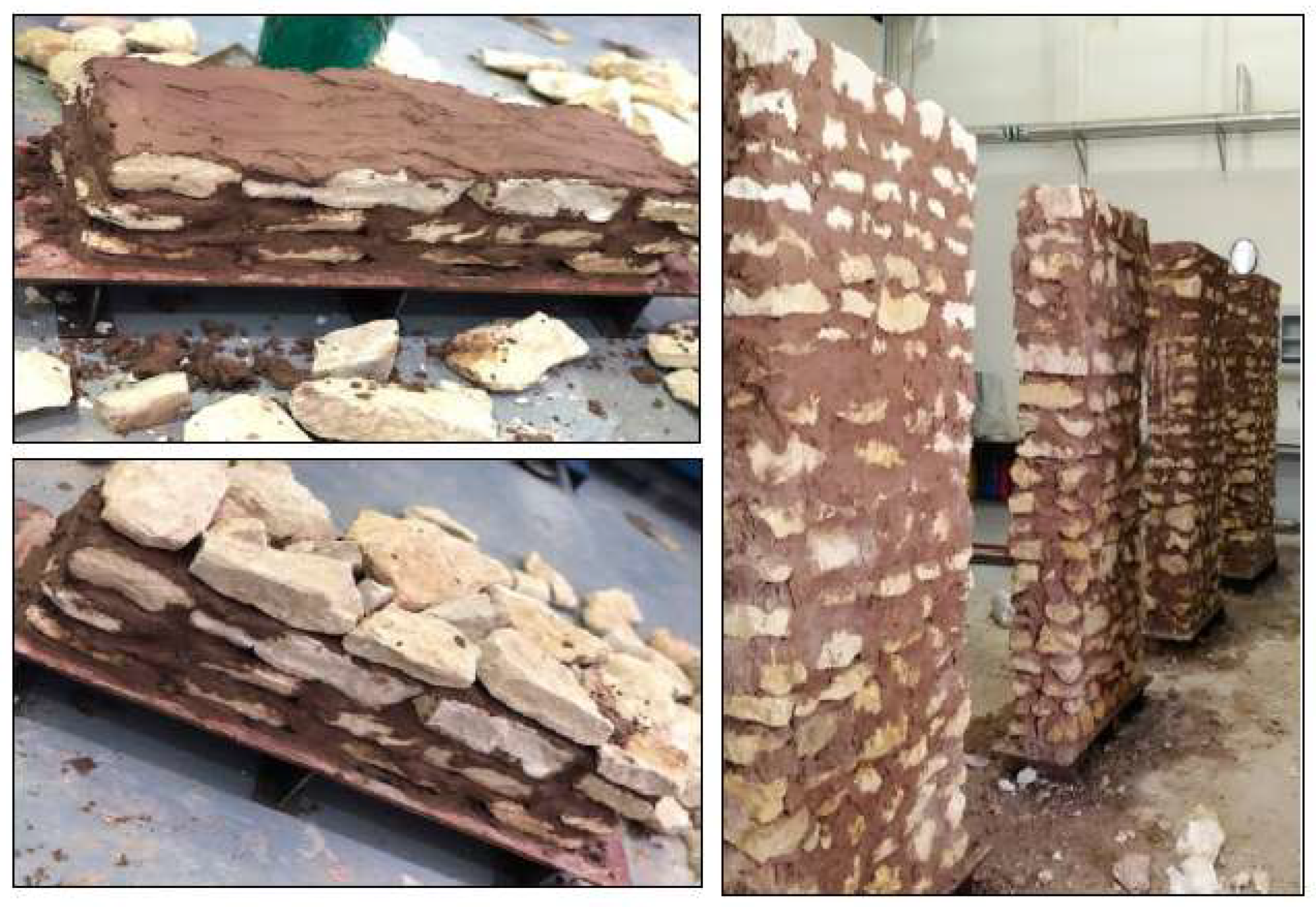
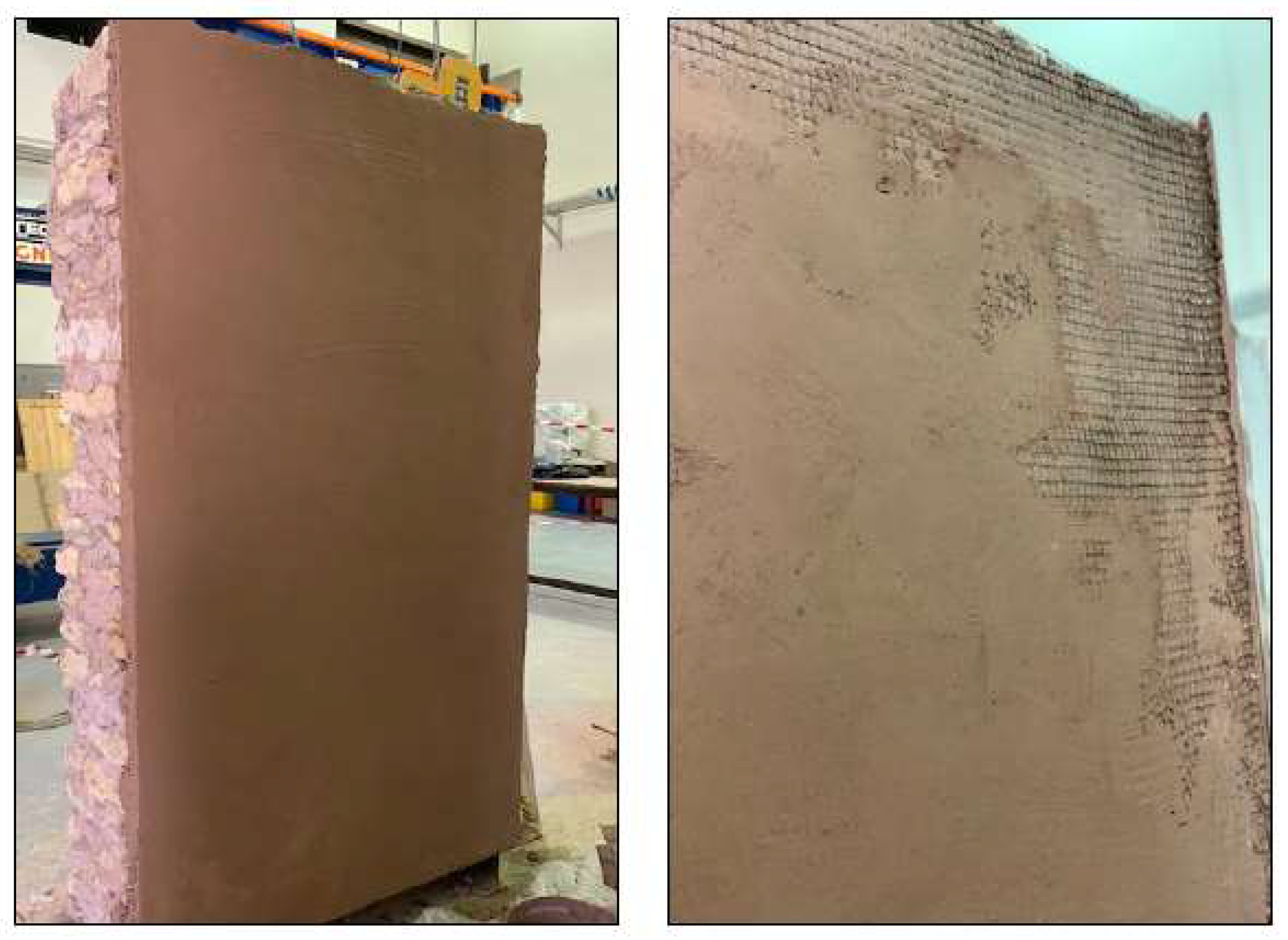
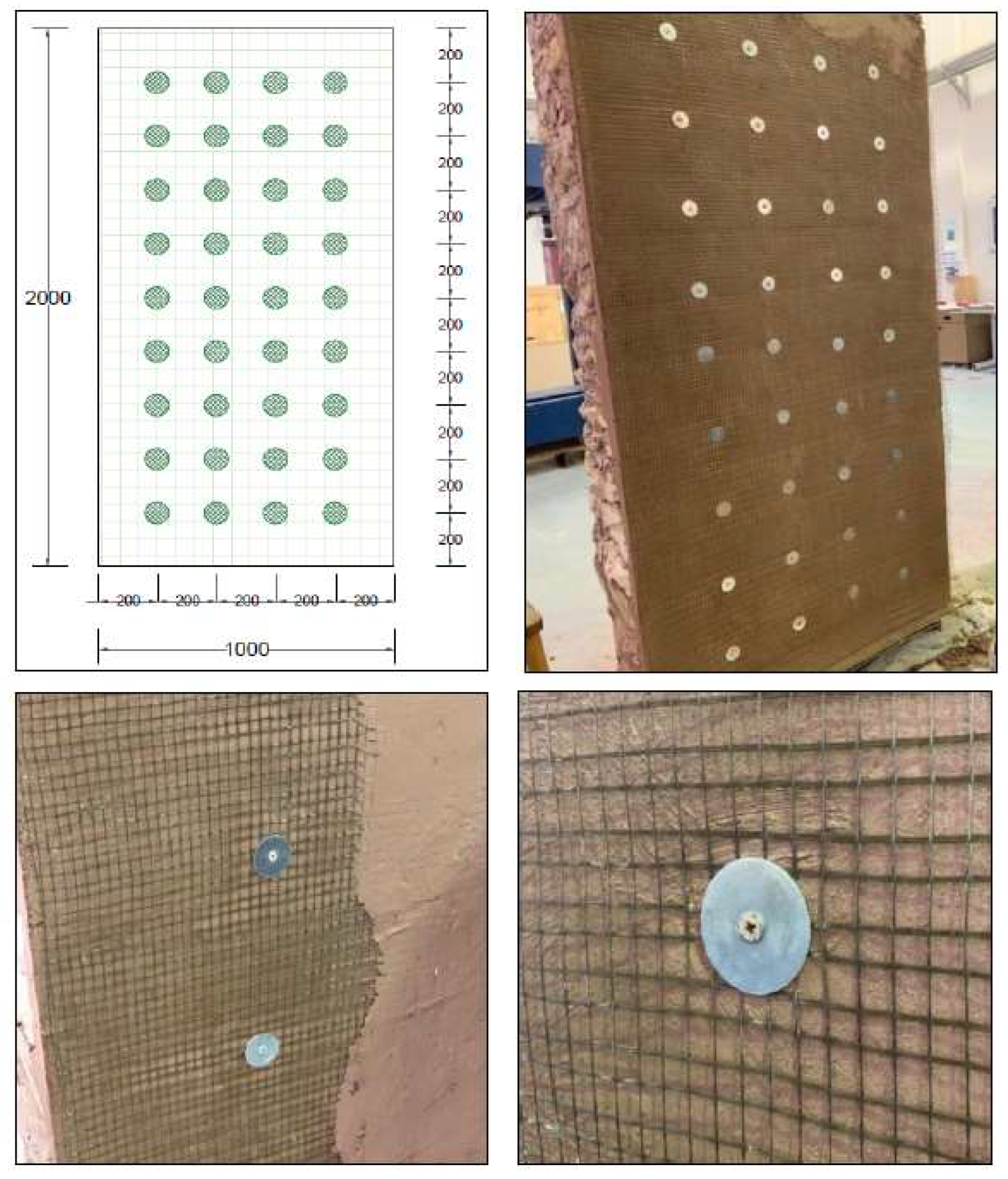
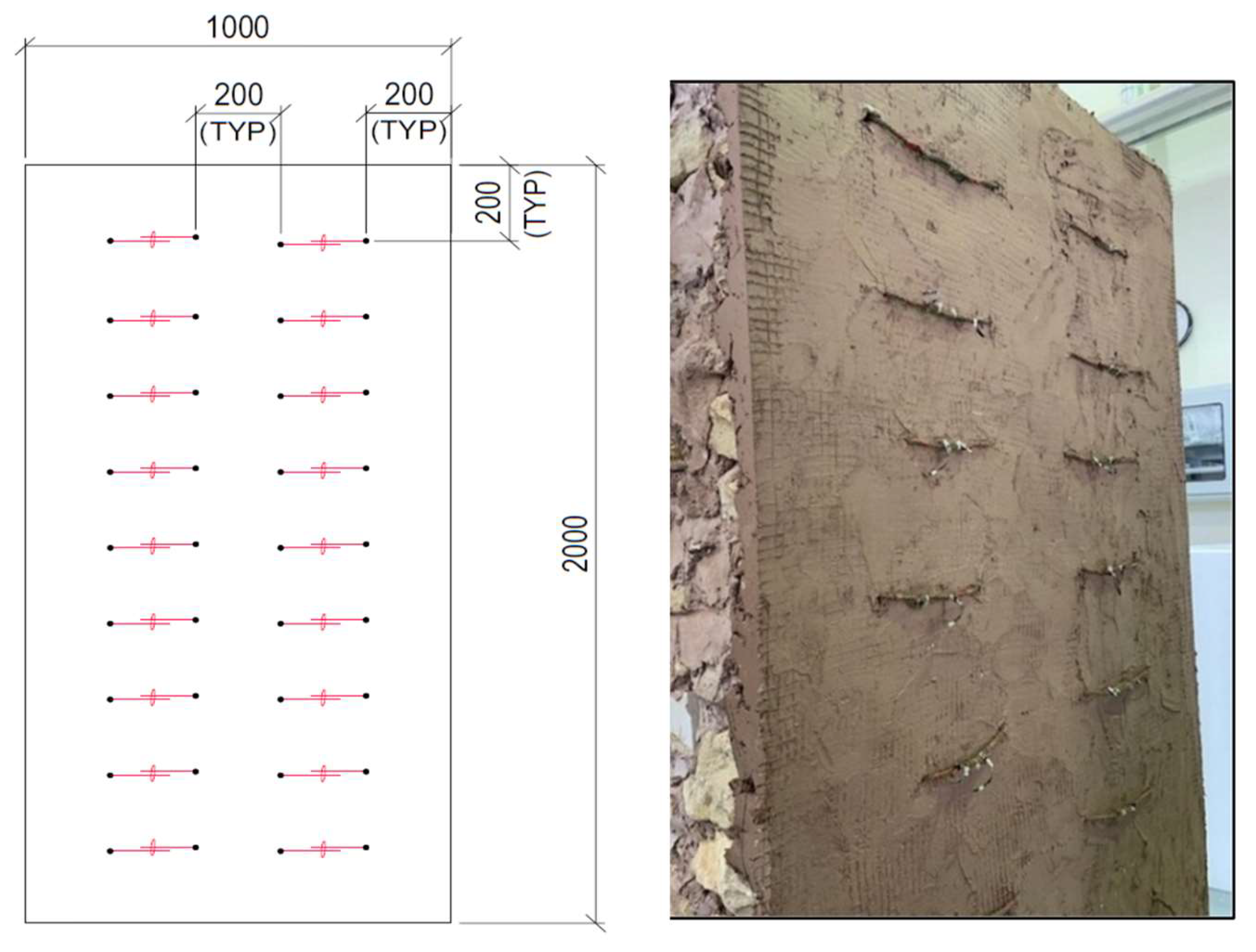
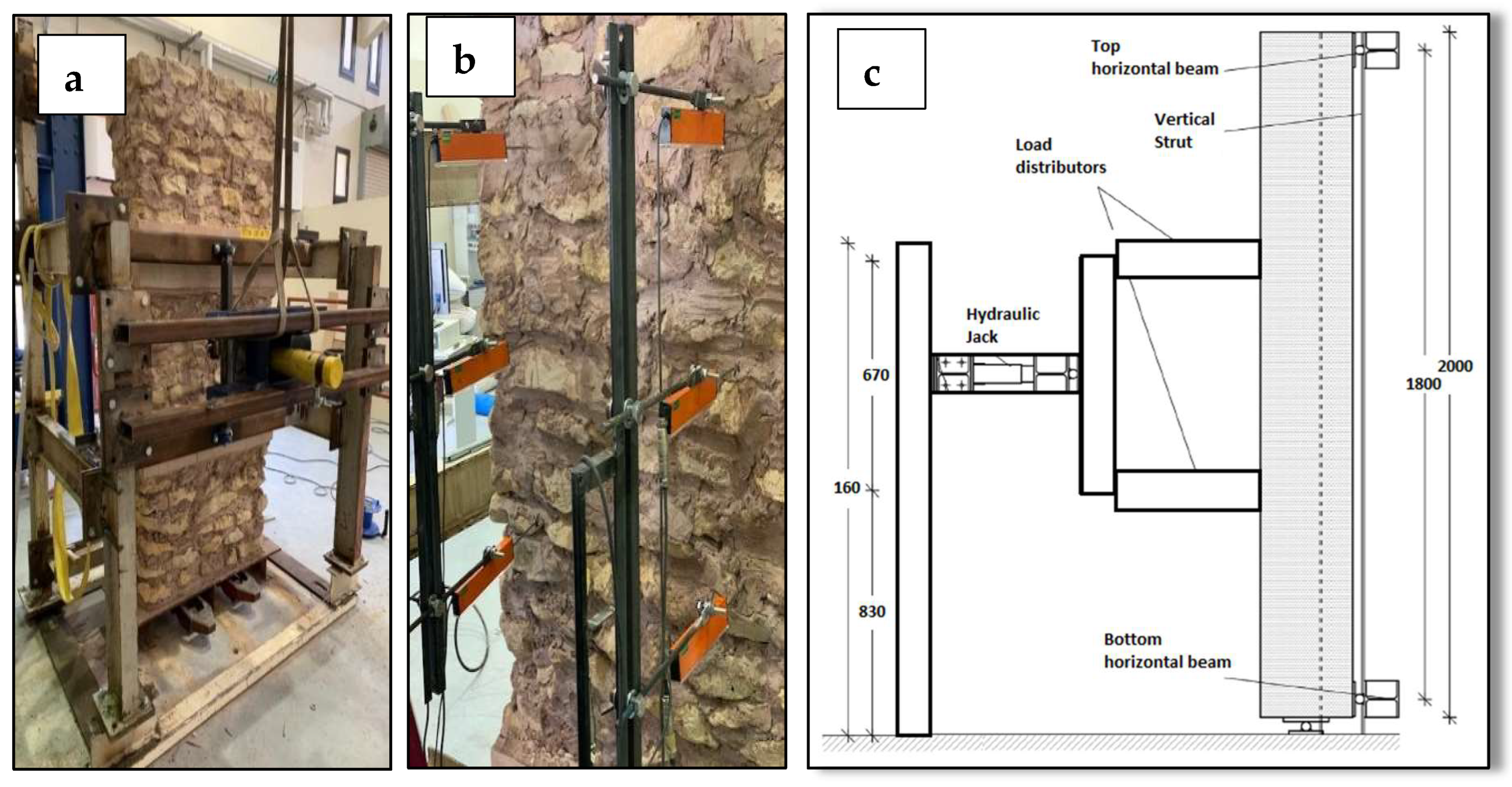

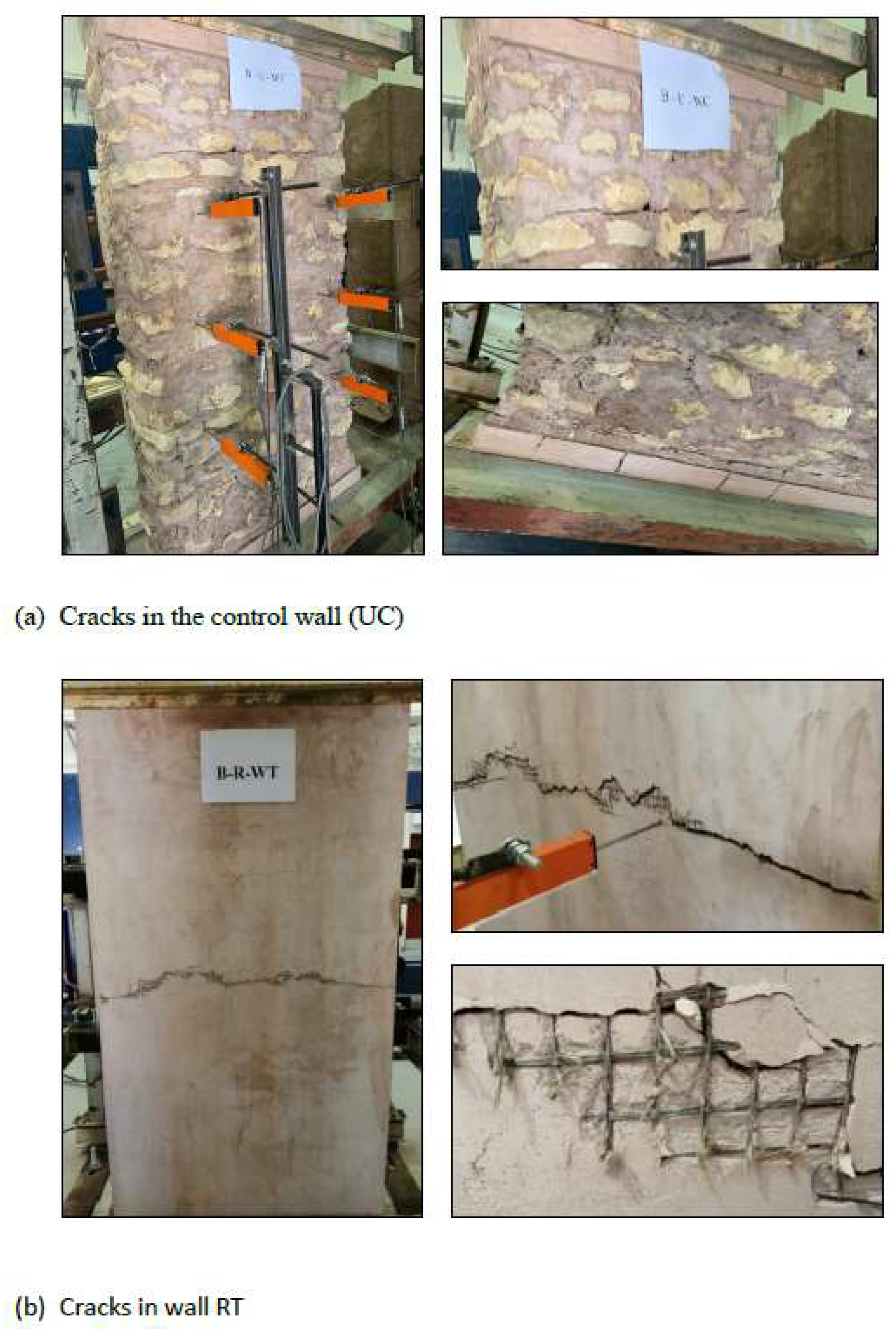

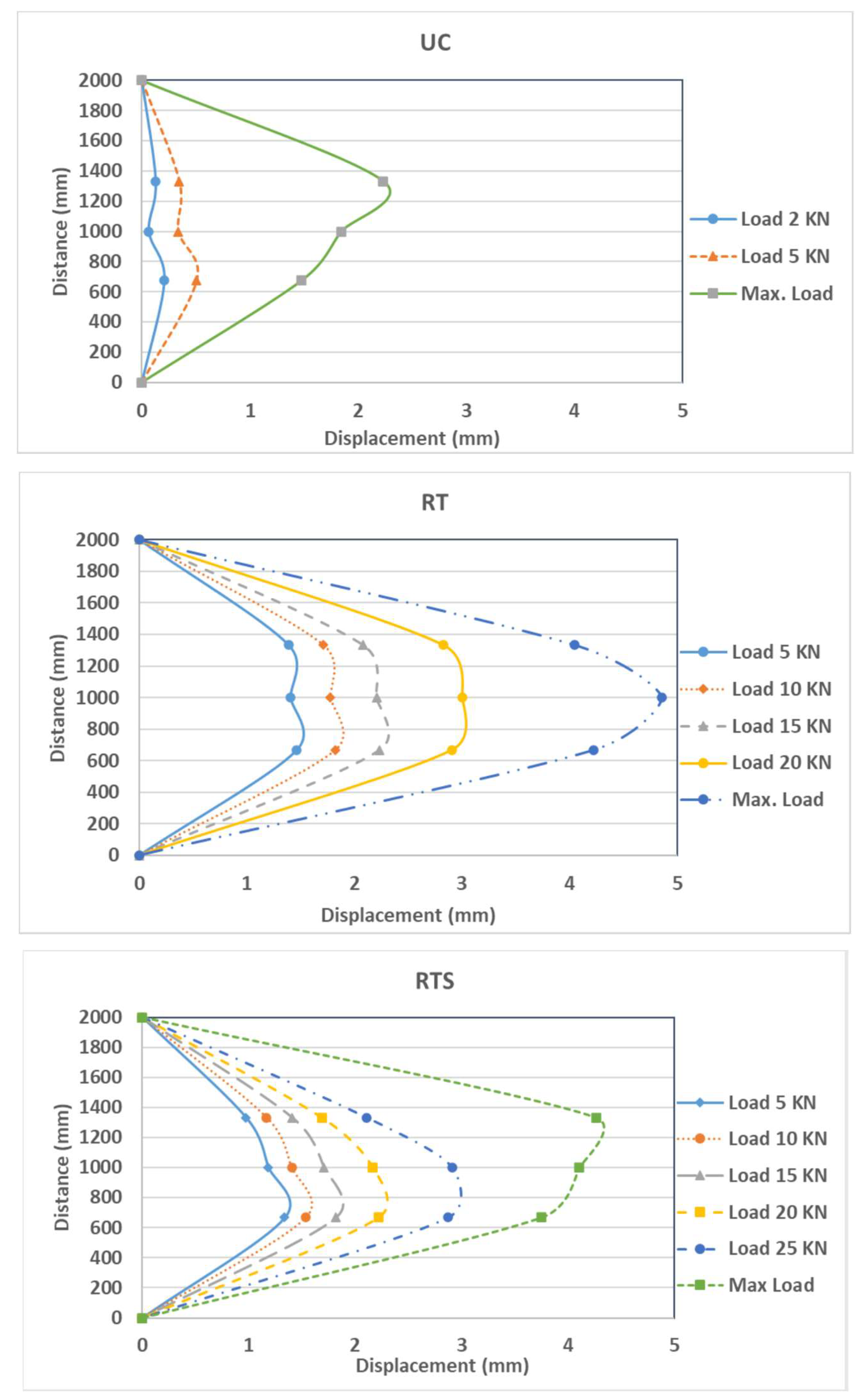
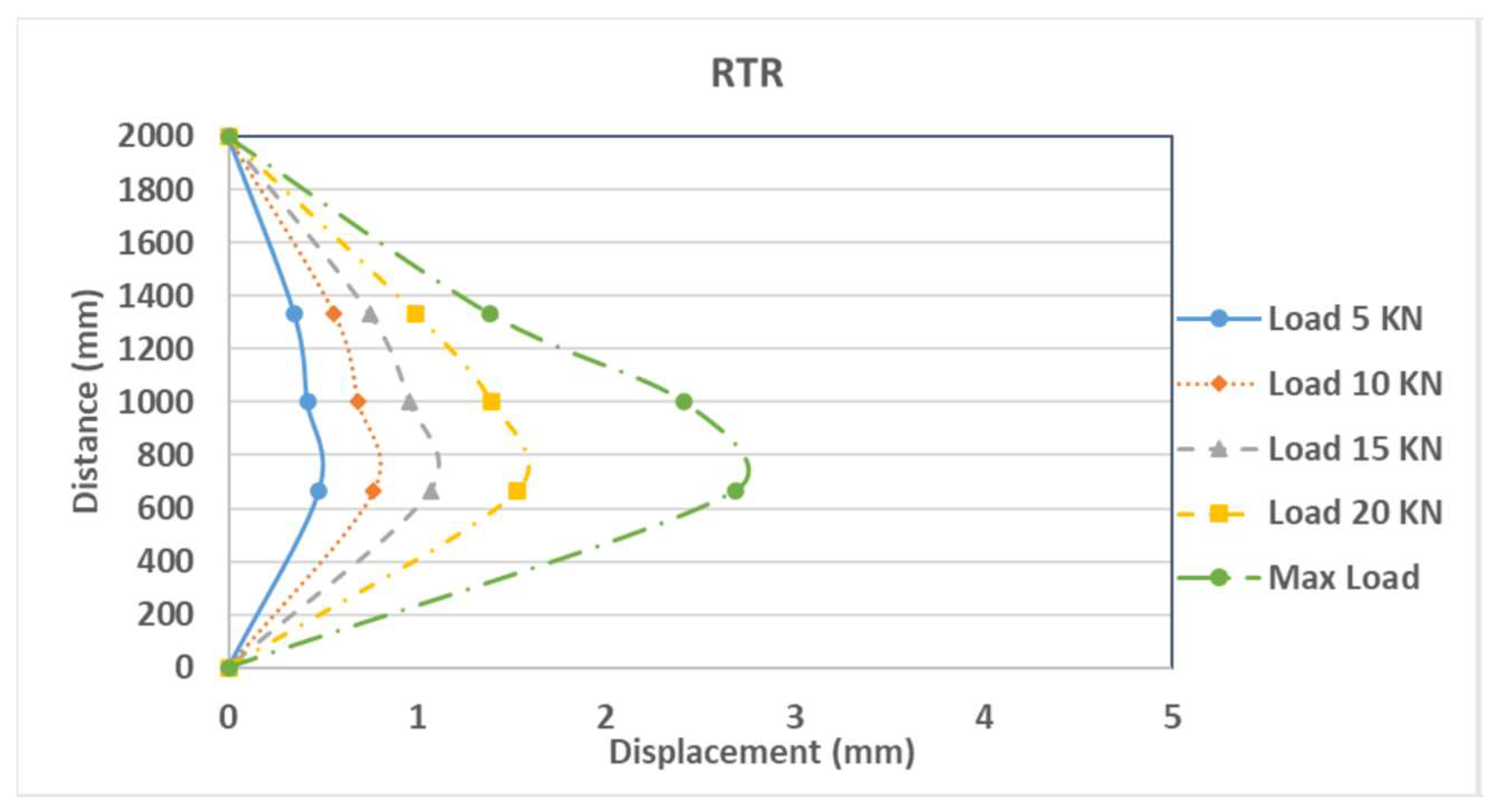


| Compound | Limestone (%) | Sarooj (%) |
|---|---|---|
| SiO2 | 10.33 | 29.08 |
| TiO2 | 0.73 | 0.41 |
| Al2O3 | 1.27 | 10.91 |
| Fe2O3 | 1.47 | 11.99 |
| MnO | 0.03 | 0.143 |
| MgO | 1.64 | 11.55 |
| CaO | 68.55 | 24.47 |
| Na2O | 0.74 | 4.44 |
| K2O | 0.1 | 0.94 |
| P2O5 | 0.02 | 0.15 |
| Specimens | 1 | 2 | 3 | 4 |
|---|---|---|---|---|
| Tag. | UC | RT | RTS | RTR |
| Textile | _ | Basalt | Basalt | Basalt |
| Specimens | Control | Strengthened with Textile | Textile + Screws | Textile + Basalt Rope |
| Specimen | Pcr (kN) | Pu (kN) | Δcr (mm) | Δu (mm) | Mcr (kN.m) | Mu (kN.m) | Mu/MUC | Mtheor (kN.m) |
|---|---|---|---|---|---|---|---|---|
| UC | 9.51 | 9.51 | 0.5 | 1.99 | 2.60 | 2.60 | 1.0 | - |
| RT | 20.21 | 25.81 | 2.85 | 4.61 | 5.63 | 7.22 | 2.78 | 8.4 |
| RTS | 19.11 | 30.92 | 1.99 | 4.11 | 5.32 | 8.66 | 3.33 | 8.4 |
| RTR | 20.25 | 24.17 | 1.48 | 2.42 | 5.64 | 6.75 | 2.60 | 8.4 |
Disclaimer/Publisher’s Note: The statements, opinions and data contained in all publications are solely those of the individual author(s) and contributor(s) and not of MDPI and/or the editor(s). MDPI and/or the editor(s) disclaim responsibility for any injury to people or property resulting from any ideas, methods, instructions or products referred to in the content. |
© 2023 by the authors. Licensee MDPI, Basel, Switzerland. This article is an open access article distributed under the terms and conditions of the Creative Commons Attribution (CC BY) license (https://creativecommons.org/licenses/by/4.0/).
Share and Cite
Al-Saidy, A.H.; Al-Busaidi, M.; El-Gamal, S.; Abu Sohel, K.M. Flexural Strengthening of Stone Masonry Walls Using Textile-Reinforced Sarooj Mortar. Materials 2023, 16, 5703. https://doi.org/10.3390/ma16165703
Al-Saidy AH, Al-Busaidi M, El-Gamal S, Abu Sohel KM. Flexural Strengthening of Stone Masonry Walls Using Textile-Reinforced Sarooj Mortar. Materials. 2023; 16(16):5703. https://doi.org/10.3390/ma16165703
Chicago/Turabian StyleAl-Saidy, Abdullah Hilal, Manal Al-Busaidi, Sherif El-Gamal, and Kazi Md Abu Sohel. 2023. "Flexural Strengthening of Stone Masonry Walls Using Textile-Reinforced Sarooj Mortar" Materials 16, no. 16: 5703. https://doi.org/10.3390/ma16165703
APA StyleAl-Saidy, A. H., Al-Busaidi, M., El-Gamal, S., & Abu Sohel, K. M. (2023). Flexural Strengthening of Stone Masonry Walls Using Textile-Reinforced Sarooj Mortar. Materials, 16(16), 5703. https://doi.org/10.3390/ma16165703








